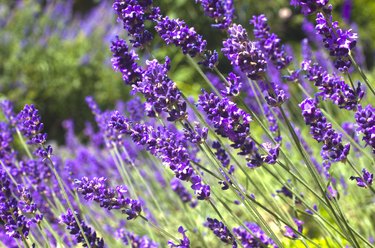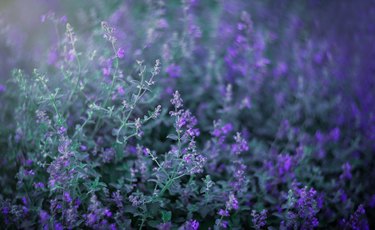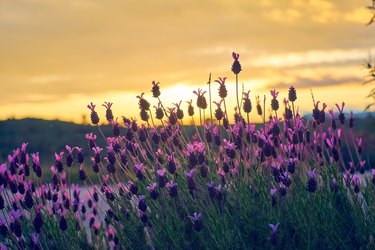
Purple flowers are gorgeous and can add a wonderful dose of color to any garden. If you have a purple plant in your yard, you may be wondering if it is English lavender (Lavandula angustifolia, which grows in USDA plant hardiness zones 5 to 8). However, there are many plants that look like this type of lavender.
What Is English Lavender?
Video of the Day
English lavender is a low-maintenance flower that comes back yearly for about three to five years after initial planting. It usually blooms in the early summer and typically grows to about 2 or 3 feet in height. The English lavender plant has a square stem and green leaves that look more evergreen in warm climates and almost grayish in colder climates.
Video of the Day
English lavender is most recognizable by its vibrant purple flowers. These flowers usually bloom in late spring or early summer. Their aroma is lighter and sweeter than other varieties of lavender due to a lack of camphor, which has a piney or woodsy smell. The scent of English lavender is reminiscent of rosemary.
Plants That Look Like Lavender
Several plants are strikingly similar in appearance to English lavender. One such plant that looks like lavender but isn't is the purple giant hyssop (Agastache rugosa, which grows in zones 4 to 8). You can tell the difference between the purple giant hyssop and lavender by comparing height. The hyssop is a bit taller than English lavender at about 4 feet tall. It too is fragrant, but hyssop smells more like black licorice and mint. Hyssop is a hardier plant than lavender and might be an excellent alternative to lavender in more humid climates.
In addition to the purple giant hyssop, certain varieties of salvia plants (Salvia officinalis, which generally grows in zones 4 to 10) can also look a lot like lavender, especially meadow sage (Salvia nemorosa, growing in zones 4 to 8) and Russian sage (Perovskia atriplicifolia, which grows in zones 5 to 9). Meadow sage is shorter than English lavender, although its flowers are also a bright purple color. Meadow sage also makes an excellent low-growing perennial for sun and tends to bloom in the late spring and early summer. It's terrific for attracting butterflies to your garden and smells somewhat like lavender, although its scent is more pungent.

Russian sage also has grayish-green foliage like English lavender, but it tends to grow a bit taller. It also has a later bloom, usually from July to October. A Russian sage's flowers are a bit bluer in color than lavender. However, it's a fragrant plant and sometimes smells like lavender, which makes it another great alternative, although its smell is woodier and more like sage. The Russian sage can withstand cooler temperatures better than lavender.
Other Varieties of Lavender
Besides English lavender, there are several other types of this aromatic flowering plant that look very similar, even though English lavender is sometimes called "true lavender." French lavender (Lavandula stoechas, growing in zones 6 and above), on the other hand, has toothed leaves and smells woodier. It also has a much more extended bloom period in warm climates.

Lavandin (Lavandula x intermedia, which grows in zones 5 to 9) is a hybrid lavender plant. Its flowers can be lighter in color and bloom later in the summer. This variety has a more pungent smell and longer stems, and it tolerates heat very well.
Finally, Spanish lavender (Lavandula stoechas, which grows in zones 7 to 9), also known as butterfly lavender, has silvery leaves and is similar to French lavender. Spanish lavender also has beautiful "ears" that grow from the flower's head. They're very aromatic, which is one of the reasons butterflies like them so much. They bloom in abundance from the late spring through the summer months.